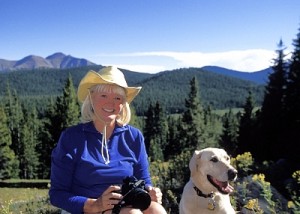Sidebar by Martha Quillen
Water – June 2005 – Colorado Central Magazine
FOR NEWCOMERS unfamiliar with local politics, the Upper Arkansas Water Conservancy District was formed back in 1979 to help develop water in the Upper Arkansas Valley before rapidly growing front range communities could purchase it.
In Colorado, special taxing districts can be formed to build water projects or to help manage and develop water. Such Water Conservancy Districts vary greatly in size and purpose, and although they are originally instituted by a vote, boards are subsequently court-appointed.
The rallying cry behind founding the UAWCD was to preserve our rural lifestyle by keeping our water right here in our own mountain valley. To accomplish that, the district’s primary efforts have been two-fold: to find and supply water for local users, and to provide legal expertise when conflicts with downstream users arise.
But in Colorado, agricultural usage currently consumes more than 80% of our water, yet provides less than 8% of our earnings. Thus economic factors have favored converting ag water into domestic water, and that’s what’s happening today — both here and elsewhere.
In fact, the UAWCD’s principal role today is to sell well augmentations in order to supply water for new housing in our region. An augmentation plan shows that you’ve purchased water to put in the river to replace the well water you consume — and that protects downstream users.
But who makes sure that there’s enough water for local wells?
Well, that’s a good question, but it’s not readily answerable. The amount of groundwater available for wells in our basin is not clear-cut. Yet in order to keep the front range from grabbing our water, we’ve been selling it ourselves.
Clearly, making it easier to mine local groundwater so that we could keep front range cities from getting it may not have been the best idea we’ve ever had. But lets face it, Colorado’s rural areas don’t seem to be bustling with economic opportunities, and construction, real estate, growth, and second homes put a lot of the food on our tables.
Thus, the UAWCD continues to sell augmentation permits. And the agency also documents and regulates augmentation plans as required by state law — which is one of the reasons other counties have recently expressed interest in welcoming the UAWCD into their regions.
In many cases in Colorado, developers have presented augmentation plans, but have failed to follow through. In other words, they’ve put in wells, but haven’t actually kept up with the augmentation plans, which have to be kept long-term in order to replace water year after year — until the wells are no longer in use.
The Upper Arkansas Water Conservancy District performs this vital function. But in doing so, the agency profits from issuing augmentation permits, which makes its governmental role problematical.
Augmentation makes it easier to develop rural land, but that use of our water isn’t necessarily in the best interest of townspeople, wildlife, recreationists, or even ranchers.
In essence, citizens pay taxes to manage and safeguard their water. But as rural regions change into tourist zones there are more conflicts between urban, suburban, and rural users, and also between older settlements, new developments, and wildlife.
Although there’s long been a movement afoot to make water conservancy districts more democratic and representational, both the powers that be and Colorado residents seem to fear that the issues are too complex for ordinary citizens. But as things are, Colorado’s conservancy districts tend to be controlled by ranchers and real estate developers because they have considerable experience in water matters, but their interests are decidedly commercial and not particularly representative.
And to makes matters worse, the UAWCD is still structured to facilitate development, first and foremost — as if merely keeping our water here in the mountains (even if it all goes to irrigate new gated communities with privatge golf courses and polo grounds) is in the best interests of most citizens.
In the long run, the resolution of Colorado’s water issues will do more to determine what kind of communities we live in than any vision or plan. Will our cities grow or decay? Will they sprawl? Will we still have ranches and small towns left? Or will everything here get too expensive for ordinary working people?
Citizens who care about such things need to understand local water issues.
Yet so many otherwise savvy newcomers seem to feel overwhelmed by the prospect of delving into Colorado water issues…

